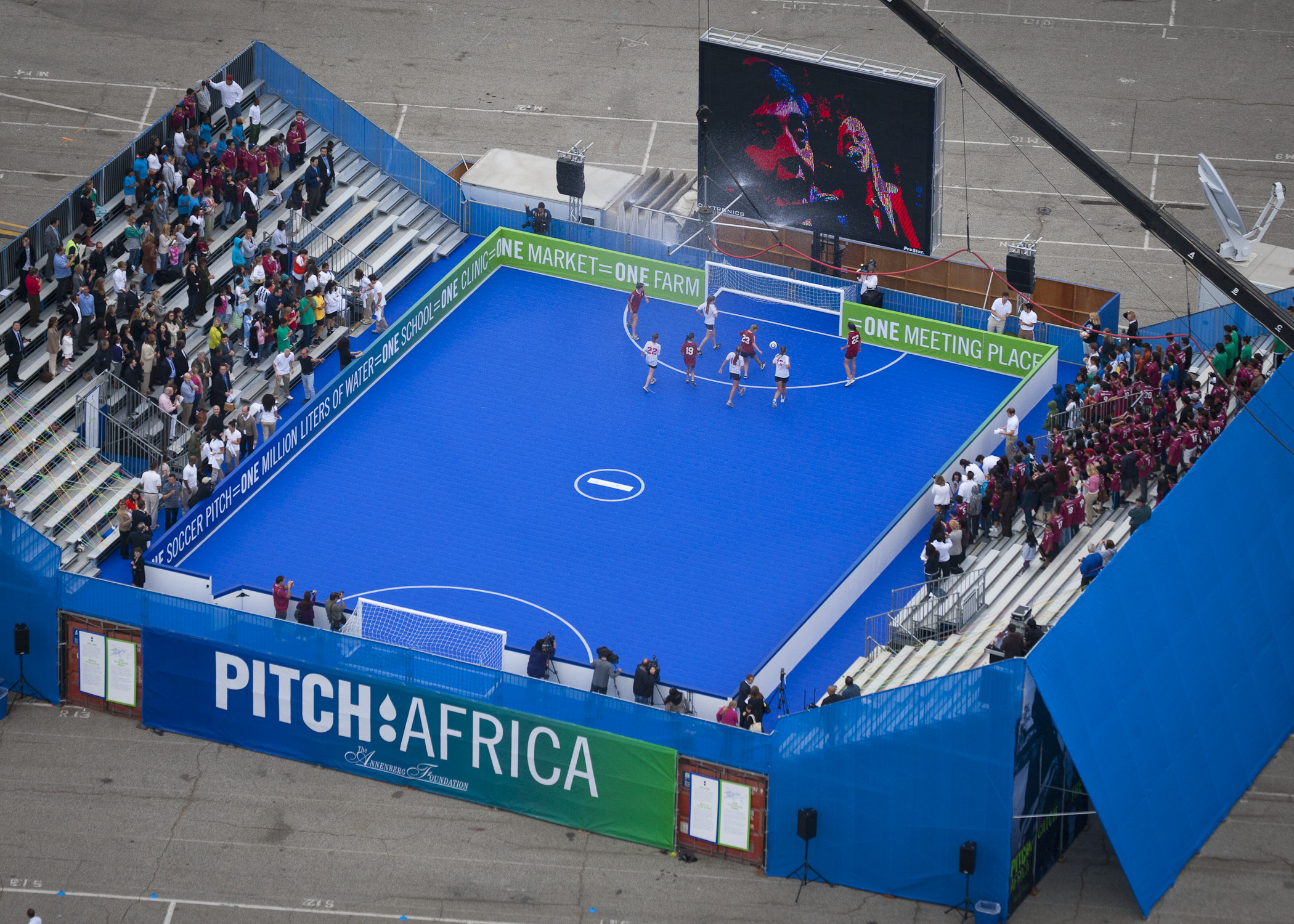The day after Spain won the World Cup in Johannesburg, I met Monday with architects David Turnbull and Jane Harrison, a husband-and-wife team who put together a demonstration project at the Port of Los Angeles in San Pedro called "Pitch: Africa."
The project sounds downright prosaic: It's essentially about low-tech strategies for capturing rainwater to support impoverished farmers in Africa, who have poor access to water of any kind, let alone drinking water but great enthusiasm for soccer. (The location of the demonstration project in California may have been a nod to the local Annenberg Foundation, which sponsored Pitch Africa; the large asphalt parking lot of Berth 87 at the port allowed a large area in which to stage the project free of cost.) The conversation I had with Turnbull and Harrison--he currently teaches at Princeton, she at Columbia--was one of the most stimulating and far-ranging conversations I have had in months.
"Pitch" in this context means playing field. The pitch is a small, temporary soccer stadium, elevated about 10 feet off the ground, with conventional bleachers on either side. The smaller-than-regulation size soccer field measures about 80 by 64 feet.
The size of the stadium is meant to reflect the dimensions of the water-collection tank housed beneath the playing field. (The current construction was actually a scale model of a proposed soccer field-plus-water collection and purification plant in Africa, which could hold 1 million liters of water.) The choice of a soccer stadium hints at the designers' concerns about making the water collection system compatible with existing structures. In the loose-knit urbanism of rural, agrarian Africa, a soccer field makes a good fit in a market area, without introducing any foreign-looking infrastructure into traditional contexts.
The playing surface is floored in permeable plastic tiles that allow water to percolate to the holding tank below. The reservoir gravity-feeds the water to a group of five-gallon tanks containing sand located directly beneath it. With the help of several other low-tech filtering devices, the rainwater can be made fit to drink. One of the many extraordinary gadgets, which can be virtually anywhere in the world with native materials is a filter made of clay and sawdust (!). When fired in a kiln, the sawdust burns away, leaving a very fine system of pores throughout the clay matrix; some of the pores are small enough to sift out potentially lethal contaminants, such as E. coli bacteria.
Another clever clay gadget is a bowl glazed on one side only; the water in the bowl is attracted to the porous, non-glazed side of the bowl, which induces evaporation, cooling the walls of the clay pot along with the water inside it. A related clay gadget is a primitive refrigerator, that consists essentially of two or more clay vessels, one nested inside the other like babushka dolls. This device creates a multiple cycle of evaporative cooling, that can keep food fresh for a day or two.
Granted, Africa probably needs these technologies more acutely as anyplace else. But the simplicity and cheapness of this technology (simple in its outcome, that is, not in the underlying research) has meaning for us in California. Los Angeles County has proposed an ordinance for all households and businesses to capture their storm runoff. Business interests have predictably pushed back against the proposed regs, claiming that capturing runoff would add an onerous cost to small business. Turnbull's and Harrison's demonstration project shows how an unintrusive, inexpensive technology can help Los Angeles County, which, like many places in sub-Saharan Africa, has adequate rainfall but captures almost none of it.
How, then, to incorporate the water works in a way that will not make the filtering apparatus one more piece of clunky, anti-social, neighborhood-destroying infrastructure? Well, hide it inside of public buildings, schools, hospitals. Or build a soccer field next to the traditional marketplace, so people can collect drinking water in 1 gallon jugs, rather than walk 25 miles, in some cases, to the nearest drinking water. Provision of water is thus an urban planning issue that can be sensitive to local culture and context.
The availability of water where previous unavailable can also have a huge impact on education in Africa. One example: the ready availability of water for personal hygiene would make it possible for adolescent girls to attend school. (Because of the lack of toilets and water, girls often must skip school when they menstruate – if they go at all.) So water is a feminist issue too.
In addition, all of us by now are aware that rivers that supply water to entire nations are diminishing, while population continues to spike worldwide. I believe that our children will witness resource wars, including wars over the mountains (i.e. Himalayas) that provide the headwaters for important rivers. So providing a new source of water becomes a geo-political issue, as well.
To say I was inspired would be overly mild. I was radicalized. To hell with "star-chitects." This is what architects should be doing: Using design skills to solve real problems. Amen, and pass the potable water.
Here's a video of the demonstration project.
Annenberg Foundation Pitch:Africa page.
--Morris Newman
